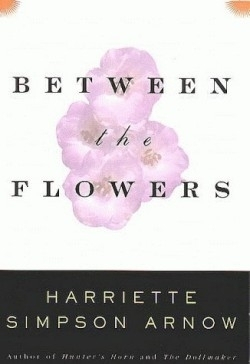Between the Flowers
Posthumous publication, even posthumous praise, is bittersweet vindication and at the least a cautionary tale of nearsighted commercial aims. In the mid 1930s, Arnow, a young Kentucky writer being groomed to be a distaff rival to John Steinbeck and his novels of agrarian social realism, submitted Between the Flowers, her second novel. But despite her New York editor’s revisions, it was roundly rejected, and the dispirited author would not write again for over a decade. Though she later received critical acclaim for Hunter’s Horn and, in 1954, The Dollmaker (the latter, an Appalachian woman’s part in the industrial labor migration north during World War II, became a television film starring Jane Fonda), Between the Flowers was only a yellowed manuscript at the author’s death in 1986.
Given this history, Michigan State University Press? critical editions of Arnow’s later novels and essays do not guarantee that this early effort will rise to the occasion, but the good news is that it does: like finding a pressed flower that stubbornly retains its aroma and beauty long after its original season, Between the Flowers is a lovely, true-speaking, engrossing account of a Kentucky farmer’s marriage—exactly the non-melodramatic novel her editor had urged her to write, as Frederic J. Svoboda, English department chairman at University of Michigan—Flint notes in his foreword.
Well-paced in plot, the novel follows the dreamy headstrong Delph and the stolid farmer she elopes with. Arnow is not the first to write of the lonely isolation within marriage, but she draws on the hardships and ethos of rural society in a style that is colloquial yet profound. Reading the novel is like walking past an old farm and finding everything just as it was left, buttermilk cooling in the ice house, hounds baying, church soloists sweetly tempering the harsh sermons. Up through the last page, a cruel irony of husband and wife misreading the other’s heart, Between the Flowers gives a weighted sense of how life is ultimately earth-bound.
From Thomas Hardy’s dark fatalism in his Wessex villagers? lives to the cruel economics of Edith Wharton’s women spending their brief allotment of pleasure, Arnow brings tradition to her folk realism, an American woman writing on the cusp between the nation’s proud agrarian past and its modern urban pulse.
Reviewed by
Leeta Taylor
Disclosure: This article is not an endorsement, but a review. The publisher of this book provided free copies of the book to have their book reviewed by a professional reviewer. No fee was paid by the publisher for this review. Foreword Reviews only recommends books that we love. Foreword Magazine, Inc. is disclosing this in accordance with the Federal Trade Commission’s 16 CFR, Part 255.

